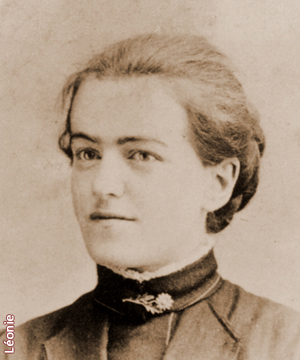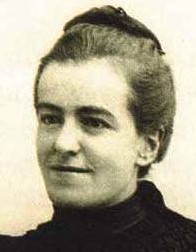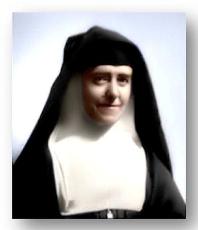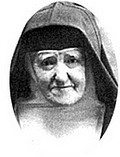LÉONIE - “I want to become a true religious.”






Marie Léonie Martin was born on June 3, 1863, with blonde hair and blue eyes, the third child of nine. However, her physical health was not good. After overcoming whooping cough, she contracted measles and had violent convulsions. She was cured of these after her parents prayed a novena for her healing. However, she developed a severe case of eczema, which lasted her entire life.
Léonie was a difficult child, prone to tantrums. In 1871, Zélie tried to enroll her at the Visitation boarding school where her two older daughters were already studying; however, due to her undisciplined nature and a learning disability, the Mother Superior rejected her. Zélie’s sister, Sr. Marie-Dosithée, who taught at the school, intervened. The Mother Superior relented, but, unfortunately, due to Léonie’s unruliness and her inability to learn, she was sent home. In January of 1874, she was allowed to return but was expelled after three months. As a result, Zélie began home schooling her. In December 1876, Zélie was diagnosed with breast cancer. Léonie was devastated by the news of her mother’s illness and spent a lot of time either alone in her room or with the maid. Before Zélie’s sister, Sr. Marie-Dosithée, died of Tuberculosis in February 1877, Léonie wrote her a letter: “My dear Aunt, when you get to Heaven, will you please ask God to convert me and to give me a vocation to become a true religious.”
A couple of weeks passed, and the secret to much of Léonie’s bad behavior was revealed. Louise Marais, a local country girl whom Zélie had taken into their home in 1865 when she was only 16, worked for the Martins as a maid. She decided to discipline the child who seemed to cause her mistress so much grief. When nobody was around, Louise beat and threatened Léonie, in order to satisfy her need for power. The tyrannical servant forced Léonie to obey no one but her. Léonie was terrified at the thought of the punishments to be inflicted if she behaved for her parents or told anyone. Then, when Léonie was 12 or 13 and Louise was about 27, Marie overhead the bullying going on in the kitchen. She confronted Louise, questioned Léonie, and told their mother the whole story. Zélie was horrified to learn it had been going on for years. She ordered Louise to leave, but Louise pleaded to stay as she had nowhere else to go. Zélie and Louis discussed it and decided it would be too cruel to dismiss her as she had no family. Besides, Zélie was so ill that she needed her help running the household. So, they allowed her to stay as long as she had no contact with Léonie and promised to leave after Zélie died. As soon as Louise lost control of her, Léonie’s behavior quickly changed and her relationship with her mother blossomed. Zélie wrote to her brother Isadore, “I cannot help thinking that this conversion is due to the prayers of our sister, for everything changed after her death.” Léonie allowed her mother to help her transform her life, and she stayed at her side until her death in August 1877 when Léonie was fourteen.
Afterwards, the family moved to Lisieux, where Léonie, Céline, and Thérèse were all enrolled in the Benedictine boarding school. After Léonie finished her studies there on October 1, 1881, she spent her time praying and caring for an old woman who was dying alone. She bathed, clothed, fed, and comforted her—and even prepared her body after she died. On October 7, 1886, at the age of 23, Léonie entered the Poor Clare monastery. Unfortunately, the rigors were too much for her to handle, and she was forced to leave after two months. In 1887, Léonie made a second attempt at religious life, and entered the Visitation Order. Regrettably, her health again prevented her from continuing and, on January 6, 1888, she returned home broken-hearted. Over five years later, in June 1893, when Léonie was 30, she traveled to Caen for a retreat at the Visitation monastery. While there, she approached the Mother Superior and asked to enter again. The Mother Superior agreed, and she joined them on June 24, 1893. Less than a year later, she received the habit and the name of Sr. Thérèse-Dosithée.
On July 29, 1894, after having suffered another heart attack, Louis Martin died. Then, less than a year later, in the Spring of 1895, Sr. Marie Lefrançois was elected the new Mother Superior of the Visitation Order and created stricter guidelines. Léonie and some of the other postulants found it too hard to follow the rigors of these new rules and were asked to leave. On July 20, 1895, Uncle Isidore picked Léonie up and brought her back to his home. She cried so much that she couldn’t speak. At this time, Céline was no longer living with the Guérins, having left for the Carmel in 1894. For the next five years that she lived there, Léonie became very close with them.
On July 2, 1897, Léonie went to the Carmel to visit her sister Thérèse. It was to be the last time she saw her, as Thérèse was soon moved into the infirmary, and the Carmelite Rule did not allow visitors there. However, Thérèse continued to counsel her through letters. Finally, in 1899, at the age of 36, Léonie entered the Monastery of the Visitation at Caen for the final time. On June 30, she received the habit and the name of Sr. Françoise-Thérèse. On July 2, 1900, Léonie made her final profession and was given the jobs of Assistant Bursar, Nurse, Assistant in the Refectory, and Assistant in the Sacristy. Her Visitation Sisters described her as displaying “pure gentleness, exuberant joy, and great humility.” Of her life in the monastery Léonie wrote, “I am as happy as it is possible to be on this earth.” During the coming years, she became one of the first and best disciples of Thérèse’s “way of confidence and love.”
On September 30, 1912, while Léonie was chanting the Holy Office, an apparition of her sister Thérèse’s hands appeared on her book. Then in April 1915, as part of the beatification process for Thérèse, an examination of her virtues took place at the Carmelite monastery so that testimony could be taken from her siblings. And so Léonie, along with her Mother Superior, traveled to Lisieux and, for the first time in seventeen years, saw her sisters. Of the next eight days they spent together, Léonie remarked, “As we sat together on the steps of Carmel, it was like we were together at Les Buissonnets once more.”
While in Lisieux, Louise Marais, the maid from her childhood, met with Léonie and apologized for her treatment of her. Léonie thanked Louise for helping to care for her mother when she had cancer, and she extended her forgiveness. When the time came for Léonie to leave, she had a hard time saying goodbye to her sisters, knowing she would not see them again on earth. When she returned to Caen, she had difficulties readjusting. The final separation from her sisters and the challenges of practicing the “Little Way” were taking a huge toll on her emotionally. Léonie remarked: “I belong to a family of saints and I must not blemish that heritage.” She especially revered Pauline as a person with great virtues. Around that time, Pauline notified Léonie that she had received permission from the Pope for Léonie to be buried at the Carmelite monastery. However, she chose to be buried at the Visitation cemetery.
On August 10, 1917, a second exhumation of Thérèse’s remains took place. While her sister Céline was wrapping her relics in silk linens, one of Thérèse’s molars fell out, and Céline decided to send it to Léonie. When she received it, Léonie was overjoyed at having something of her sister (the tooth is now on display in Caen). Thérèse’s canonization was scheduled for May 1925, and Pope Pius XI extended an invitation to all the sisters to attend; however, not one of them was able to go.
Due to the overwhelming interest in Thérèse, many visitors came to the Visitation monastery to see “the sister of St. Thérèse.” Léonie, being an assistant portress, would answer the door without letting them know they were speaking to her. Once, when a priest asked to see her, she replied, “I will ask our Mother Superior, but I do not think she will give permission for Sister Francoise-Thérèse to see you. Nevertheless, I can assure you that you will miss nothing. Speaking with her would not be worth your while.” He left stunned since it seemed that this sister was belittling Sr. Francoise-Thérèse. Almost immediately he met the chaplain of the Carmel who explained the “deception” to him. The priest was both amused and edified by her humility.
During the month of December 1930, Léonie was plagued by Grippe, a viral infection with inflammation of the respiratory tract, along with fever, chills, and muscular pain. She already suffered from a number of other illnesses, including migraine headaches and tooth loss. When she got pneumonia on top of everything else, the Visitation sisters thought that she would die. Pauline heard about it and sent a telegram to their Carmelite brethren in Rome asking for prayers. Unexpectedly, Pope Pius XI himself responded back, sending Léonie his papal blessing. Then, on January 18, 1940, Léonie’s beloved sister Marie died. As was customary, two lay sisters from Léonie’s monastery were sent to her funeral.
On May 10, 1940, Adolph Hitler’s army invaded France. The French and German governments signed an Armistice agreement that called for two zones: one to be occupied by the Germans and the other, by the French. Unfortunately, Caen and Lisieux were both in the German-occupied zone. Léonie and her Visitation sisters could no longer ignore what was going on outside the walls of their monastery. Léonie prayed ardently to her sister Thérèse for the safety and security of their family and their communities.
As 1940 was coming to a close, Léonie’s health deteriorated further. No longer able to walk and suffering from bronchitis, she was moved into the infirmary. During May of 1941, Léonie contracted Grippe for the second time and wrote to her sisters, “I have suffered so much that I have the audacity to believe that I will not go to Purgatory. I have no fear of the good God. On the contrary, it's my extreme need of Him that gives me such confidence.” At the beginning of June, Léonie showed some improvement and so her community had a celebration for her 78th birthday and her 41st anniversary of profession.
On June 12, 1941, Léonie had a stroke and was found on the floor unconscious. She woke up hours later and immediately realized that she was paralyzed on one side and couldn’t speak. When Pauline heard about it, she sent two lay sisters with messages from both herself and Céline. They also sent Marie’s rosary, Thérèse’s professional cross, and roses from their garden. As her condition deteriorated over the next five days, she clasped the rosary and the cross. On June 16, when her Visitation sisters brought in a replica of the statue of Our Lady of the Smile, Léonie smiled and held out her arms.
On June 17, 1941, Léonie’s Mother Superior hugged her twice, once for Pauline and once for Céline. Léonie sighed a couple of times and died, surrounded by her Visitation sisters. Her body was carried to the chapel choir where, despite the Nazi occupation, many people came to pay their respects. Her funeral was held on June 21, and her coffin was placed in an interior crypt in the Visitation monastery.
After her death, she was almost forgotten until around 1960, when the nuns of her monastery began to receive letters from all over the world—from parents of special children, from families in conflict, and from persons who struggled to find and fulfill their places in life. Of the four sisters of Thérèse, she is the one being especially considered for beatification. The Bishop of Bayeux-Lisieux, the Diocese where Léonie died, granted an imprimatur for a prayer asking that she will be declared "venerable." Through her intercession, God has drawn children and parents together, healed memories and relationships, and restored those in spiritual, emotional, psychological, and physical suffering. Léonie shows us that the traumas of the past are no obstacle to wholeness or to sainthood. She models the counsel Thérèse gave to her in her last letter: “The only happiness on earth is to apply oneself in always finding delightful the lot Jesus gives us.”
On January 29, 2015 Rome Reports posted a short (1:54) video chat about Leonie Martin with Father Antonio Sangalli, O.C.D., the Italian Carmelite friar who is the vice-postulator of her cause. Father Sangalli is already intimately familiar with the Martin family, for he was the vice-postulator for the cause of Leonie's parents, Louis and Zelie Martin, who have since been beatified and canonized. In this video (click here X to view), he speaks of the "incredible loyalty" with which Leonie practiced Therese's way of confidence and love.
For more information on the life of Léonie, go to wwwhelpfellowship.org/st_francoise-Thérèse OR www.Léoniemartin.org, OR read the online book, “God Made the Violet, Too,” by Fr. Albert Dolan, O.Carm., at http://babel.hathitrust.org/
NOTE: On July 2, 2015, the diocesan inquiry into Leonie's life and sanctity was opened at the chapel of the Monastery of the Visitation at Caen. She is now declared Venerable and called, "The Servant of God, Leonie Martin".
